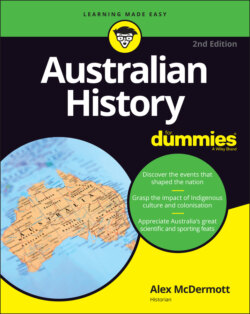Читать книгу Australian History For Dummies - Alex McDermott - Страница 95
Soldiers and common populace join forces
ОглавлениеThe 20th anniversary of NSW’s first settlement (26 January 1808) saw the majority of the population uniting as one — to arrest their own governor! At the desperate urging of ex-officer John Macarthur (who had just escaped from being jailed by Bligh), Major George Johnston led his detachment of the NSW Corps to Government House where Bligh lived. After a few hours of searching and ransacking the house high and low, the marines found and arrested Bligh.
That night bonfires were lit, people got drunk and it was difficult to find anyone in Sydney who didn’t think that the arrest of the blustering, unpredictable governor was a very good idea indeed. And if they didn’t like the idea, they (understandably) stayed fairly quiet.
Most historians will tell you that the arrest of Bligh by the NSW Corps was all about the big players — bold, bad Bligh versus Macarthur. And so on. Some have described Johnston as a ‘puppet’ of Macarthur who did his bidding in arresting Bligh.
But the real cause of the Rum Rebellion is to be found in the fact that the ordinary soldiers and common people of Sydney had become utterly meshed with each other, to the extent that the soldiers couldn’t be relied upon to do the Governor’s bidding. In a functional sense they formed a common interest.
If Johnston was a puppet it wasn’t of Macarthur, but of the common soldiers and ordinary populace.
The soldiers who deposed Bligh were in day-to-day life practically indistinguishable from the ex-convicts in both social and economic background. Most of them had been in NSW since the early 1790s. They had married or entered into de facto relationships with convict women, had children, set up businesses and established farms. The NSW Corps had ‘gone native’ in the 18 years or so since its first formation and arrival. The Corps was no longer a reliable arm of the Crown and could no longer be trusted to impose the British Government’s will on the local population.
Major George Johnston, at his trial for mutiny in England three years later, explained how the NSW Corps was inextricably involved with the people of Sydney: ‘The soldiers are not at Sydney kept in a state of separation from the people, but mix, marry and live among them, and are in all respects identified with them. They hear their grievances, and would with infinite difficulty, if at all, in a matter of great public concern, be brought to act against them’.
